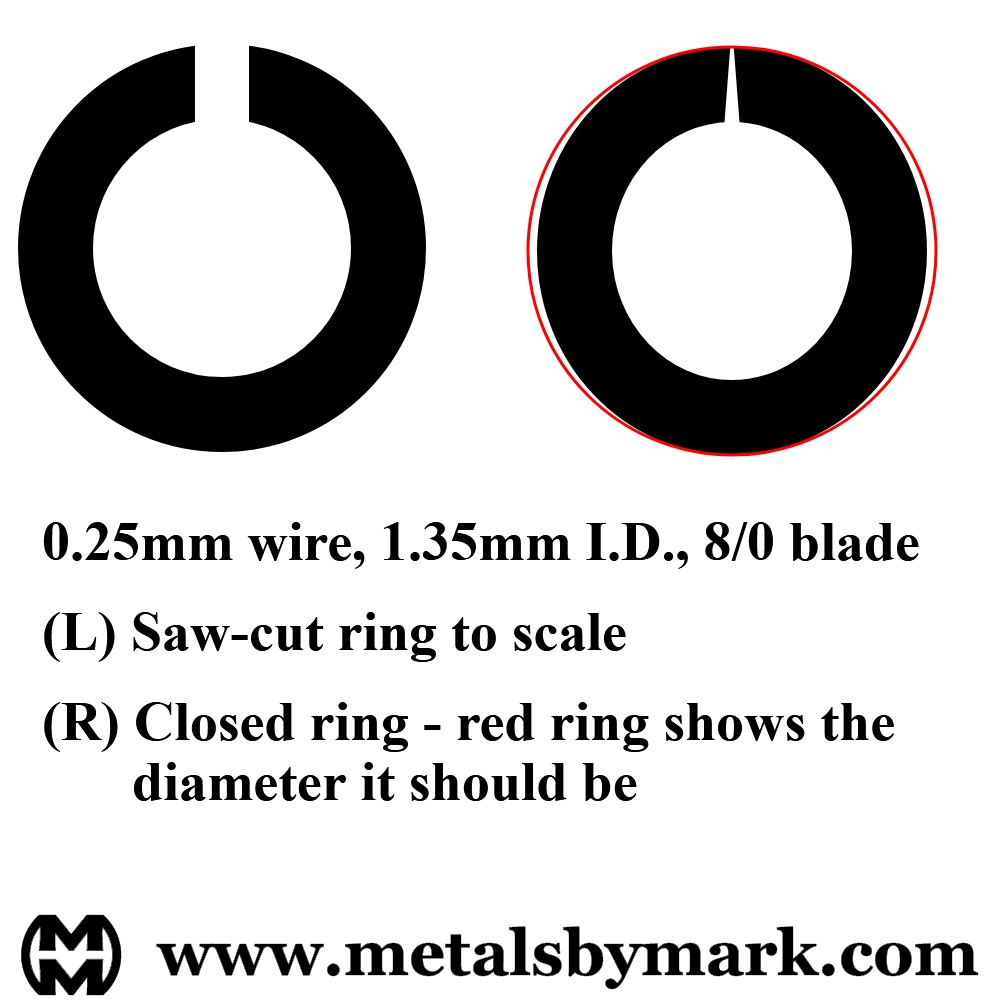
Micromaille ring example
Categories: Projects and equipment
Word count/read time: 412 words; 2 minutes
This has been on the back burner for many years.
Going full-in based on a test piece and a jewelry making tip from
a century ago, I hit the machine shop with a lofty goal.
Saw-cut rings are the only way to go.
At some point they will be so small they won't
be round when closed and the ends won't align properly.
(Technically all rings sawed from a coil
exhibit this trait but small rings are worse.)
Here's an example. A jump ring has an I.D. of
1.35mm (0.053", less than 1/16"). Cutting it with
a 0.01" thick saw blade is
nearly 20% of the inner diameter. Even a thinner 8/0 blade (0.0063")
still exceeds 10%! That ruins the
aspect ratio
as well. Sawing is futile.
Micromaille rings must have flush cuts on both ends.
The only feasible way is to use ultra-flush cutters and cut each end individually.
Don't listen to what others say because it won't work (fingernail
cutters, regular nippers, etc. - do you think they'll admit to making
low-quality rings???).
Pliers are a pain-in-the ass time toilet.
Cut one end of the to-be jump ring, flip the pliers around, cut the other end
while trying to align it in the up/down, left/right, and fore/aft planes simultaneously.
Repeat. Not so bad for onesy twoseys but making enough for a chain is prohibitive.
This tedium needs to end.
Another option to account for a blade's kerf would be a precision
CNC-made
quasi-elliptical mandrel specifically made for the ring size, wire diameter,
and saw blade thickness. In other words, fuggetaboutit!
Or you could mimic a chainmail machine which pre-cuts a wire segment
and uses two dies to form it into shape. That requires dies for every size and variation thereof,
a very precise method of cutting
segments to length with the correct matched angle on the ends to ensure there's no gap when closed,
and aligning it. Again, fuggetaboutit!
I have only seen reference to the process I'm using
a few times - never seen an actual tool, drawing, or design.
It cuts an entire coil nearly perfectly without removing material.
The specifics will remain a secret.
Compact enough to fit into the palm of my hand, it accommodates
sizes down to 1.35mm I.D. with 0.25mm wire.
Maybe even smaller, I'm still testing and tweaking the prototype.
It's only for soft metals like silver and gold, maybe copper and brass,
but that's OK because that's all I need it for.
Posted by M: September 7, 2024
Please email any thoughts or comments regarding this post.
Comment Section
NOTE: Your comments will be included in this section
as long as they aren't illegal. This section is censor-free so show me
your intelligence or ignorance and everything in between!
|
2025
Cache Me if You Can
Try, Try, Try Again
Creative Measuring
And the Exceptions Are?
Tools: Use One or Be One
Scales of Justice
Craft Fair Financials
In a Pickle
Weird Silver Items
Stop, and Think
What's a Mentor for?
Organic
Pass the Torch
Four Fs of Jewelry
Those Are Nice Dimples
Yes, I Have Some
Good Deals
Transportaion Issues
Spining in Circles
Top Purchases 2024
2024
2023
2022
2021
2020
2019
2018
2017
2016
2015
2014
|